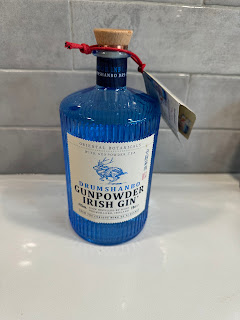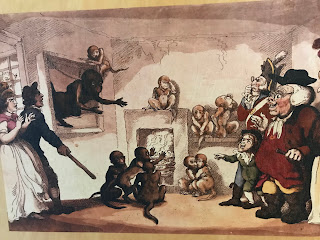Friends we haven’t seen for years bought us an intriguing present for our Ruby Anniversary. A superficial mind might consider a ruby red bottle might be more fitting, but who could drink gin from a red bottle? Are there any alcoholic drinks in red bottles? No, blue is the perfect colour whether Gunpowder Gin or Bombay Saphire. Green works too ie Tankeray, Gordons too if you’re on a budget.
I spent some time admiring the colour, unwilling to break into it too early. The small piece of cardboard around the neck of the bottle provided further distraction, especially when I opened and read it.
Who was P J Rigney? And what a journey! And all in search of botanicals. I felt vaguely transgressive. Was he another imperialist I should be ashamed of, plundering other cultures and nations for unknown and exotic plants? My imagination took me back to ‘The Great Game’ when the Russian and British empires vied with each other for influence in Central Asia.
Men like Colonel Charles Stoddart, British officer and diplomat active in Central Asia, and sent on a mission to the Emir of Bokhara in 1838.
He went with two aims: persuading the Emir to free some Russian slaves, and to sign a treaty of friendship with the British Empire. Stoddart was promptly arrested by the Emir and languished in a hot and dusty cell. In 1841 Captain Arthur Conolly arrived in Bokhara to negotiate Stoddart’s release.
This was stressing the Emir out and the two men were beheaded the following year on the square in front of the Ark Fortress. Was JP Rigby cut of the same cloth—an imperialist adventurer, his obsession with botanicals his cover in the Great Game? I lived in hope, but alas no.
P J Rigney is alive and kicking, an Irish distiller who has been in the drink industry for well over twenty years and was for a time associated with Bailey’s Irish Cream. He may not be an adventurer in the Victorian mould, but an entrepreneur he most certainly is—with an interesting taste in botanicals:
“kaffir limes from Cambodia, Chinese lemons, and gunpowder tea from China, Orris root from he mountainous regions of Morocco, as well as juniper berries from Macedonia.”
I think it’s going to take several bottles of Drumshanbo* Gunpowder Irish Gin for me to detect the full range of his botanicals. More additions to the bucket list.
*Gaelic for old sheds on the ridge. A town in Leitrim, Ireland.












